霍桑的英文简介
- 格式:doc
- 大小:21.50 KB
- 文档页数:1


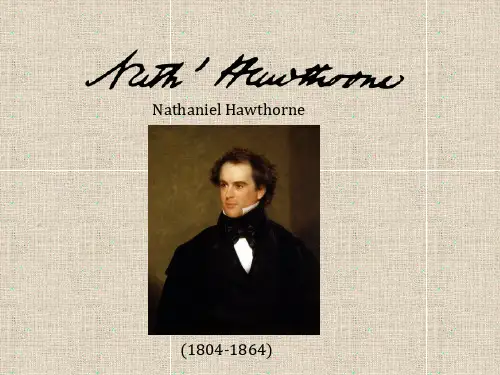
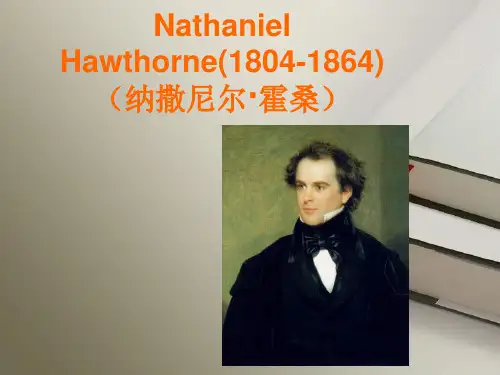
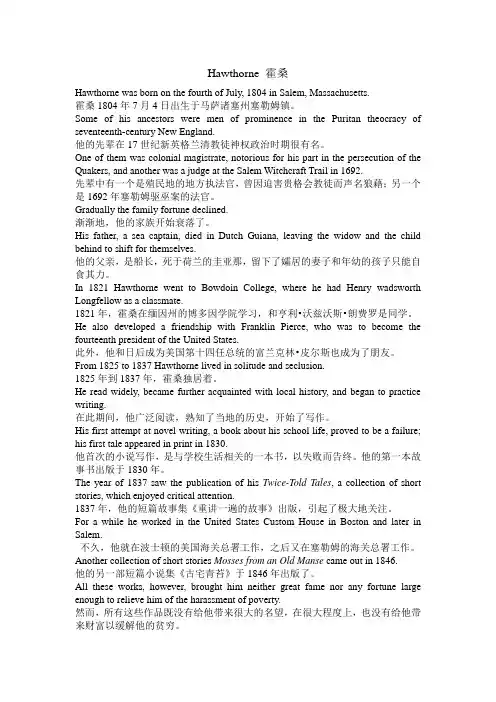
Hawthorne 霍桑Hawthorne was born on the fourth of July, 1804 in Salem, Massachusetts.霍桑1804年7月4日出生于马萨诸塞州塞勒姆镇。
Some of his ancestors were men of prominence in the Puritan theocracy of seventeenth-century New England.他的先辈在17世纪新英格兰清教徒神权政治时期很有名。
One of them was colonial magistrate, notorious for his part in the persecution of the Quakers, and another was a judge at the Salem Witchcraft Trail in 1692.先辈中有一个是殖民地的地方执法官,曾因迫害贵格会教徒而声名狼藉;另一个是1692年塞勒姆驱巫案的法官。
Gradually the family fortune declined.渐渐地,他的家族开始衰落了。
His father, a sea captain, died in Dutch Guiana, leaving the widow and the child behind to shift for themselves.他的父亲,是船长,死于荷兰的圭亚那,留下了孀居的妻子和年幼的孩子只能自食其力。
In 1821 Hawthorne went to Bowdoin College, where he had Henry wadsworth Longfellow as a classmate.1821年,霍桑在缅因州的博多因学院学习,和亨利•沃兹沃斯•朗费罗是同学。
He also developed a friendship with Franklin Pierce, who was to become the fourteenth president of the United States.此外,他和日后成为美国第十四任总统的富兰克林•皮尔斯也成为了朋友。


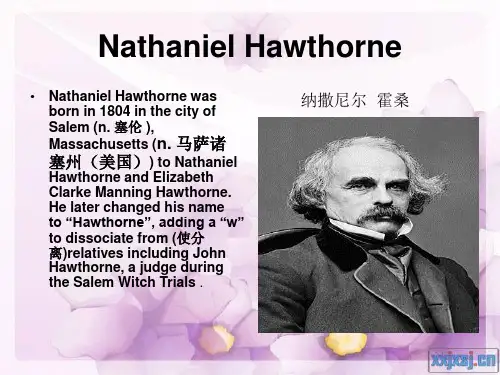
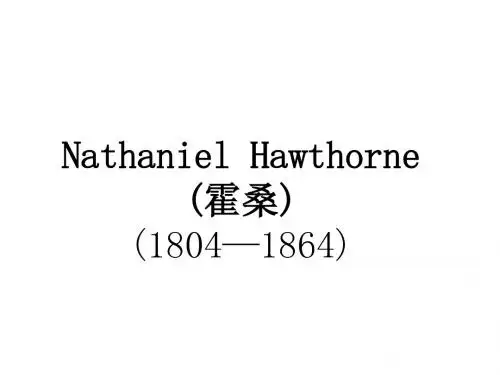
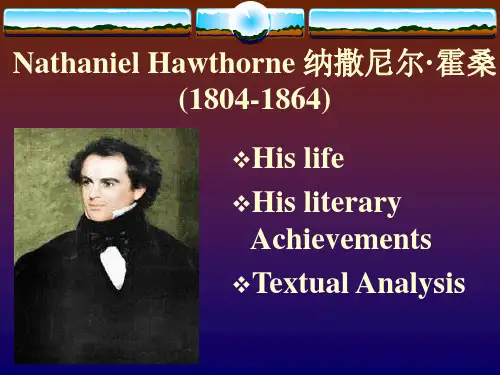
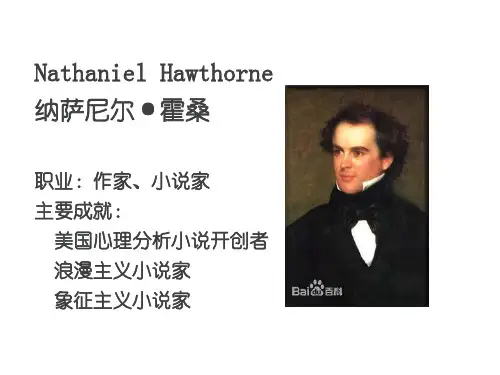
word
霍桑
纳撒尼尔·霍桑〔1804-1864〕是美国杰出的浪漫主义作家,出身于美国东部新英格兰地区的一个破落贵族世家。
笃信清教是其家族的传统,霍桑深受影响。
因父亡,4岁时他随母迁往萨莱姆依附外公家,此地历史上曾发生过“驱巫〞案,霍桑祖上曾有人充任过审理此案的法官,并以狂热严厉著称。
霍桑从小听人讲述有关的传闻,形成深刻印象,此类事件成为他日后创作的重要题材和主题。
如《七个尖屋顶的房屋》〔1851〕即描写了一个迫害无辜的家族世代遭受报应的故事。
1825年,霍桑大学毕业,并开始小说创作。
他的小说集《重讲一遍的故事》〔第一集,1837;第二集,1842〕和《古屋青苔》出版后,在文坛引起反响。
1850年,长篇小说《红字》出版,受到广泛重视,成为当时最有影响的作家。
此后,他又接连写出了长篇小说《七个尖屋顶的房屋》、《福谷传奇》〔1852〕和《玉石雕像》〔1860〕等作品。
霍桑的思想比较复杂。
成人后的霍桑厌恶清教的褊狭冷酷,常在文中加以抨击,但他始终未能摆脱清教伦理的束缚,往往从某某原罪的角度审视评判社会性罪恶,如短篇小说《教长的面纱》和《年轻小伙子布朗》,都表现了罪恶的普遍性和隐秘性的主题。
他还受到当时颇具声势的超验主义思潮影响,参与傅立叶式的农庄建设,试图从大自然的启示中找到人生真谛。
但他后来又觉得此路不通,《福谷传奇》描写的就是一群热衷于超验主义运动的知识分子社会改良计划的破产。
霍桑的小说长于形而上的思考和心理分析,常被称作“心理罗曼史〞,对美国浪漫主义文学的发展和心理小说的兴起起了很大的推动作用。
1 / 1。
霍桑生平大事转自理想藏书-作家与作品-美国相关霍桑生平大事--------------------------------------------------------------------------------纳撒尼尔·霍桑(NathanieI Hawthorne,1804-1864)霍桑,(Nathaniel Hawthorne 1804~1864)美国小说家。
1804年7月4日生于马萨诸塞州塞勒姆镇一个没落世家,1864年5月19日卒于新罕普郡的普利茅斯。
4岁丧父,1821年由亲戚资助进入博多因学院。
1825年毕业后回到塞勒姆从事写作。
曾自费出版长篇小说《范肖》,发表很多短篇作品,出版短篇集《古宅青苔》、《雪影》等。
他的短篇小说大都取材于新英格兰的历史和现实生活,着重探讨人性和人的命运,带有较浓重的宗教气息和神秘色彩。
名篇《小伙子布朗》、《教长的黑纱》等揭示人人皆有的隐秘的罪恶和人的必然的孤独处境。
一些故事反映了作者对理性、科学和技术进步的怀疑少数作品正面表达了他的理想,如《石面人像》。
1836年和1846年两度在海关任职,1841年参加超验主义者创办的布鲁克农场。
1842年后结识了作家爱默生、梭罗等。
1848年因政府更迭失去海关职位,后专心写作,完成了他最重要的长篇小说《红字》。
小说取材于殖民地时期的新英格兰生活,主人公是因犯加尔文教派所严禁的通奸罪而被标上红字示众的少妇白兰。
作者细致深入地揭示人的内心冲突,探讨了种种有关罪恶和人性的道德、哲理问题,对几个主要人物,如在磨难和赎罪中走向自新的海斯特·白兰,被良心、信仰和爱情苦苦折磨的狄姆斯台尔牧师,以及白兰的丈夫、一心谋求报复的罗杰,都有入木三分的描写。
小说以监狱和玫瑰花开场,以墓地结束,充满丰富的象征寓义。
随后发表的《带有七个尖角阁的房子》讲述品恩钦家族的祖先谋财害命而使后代遭到报应的故事,反映了早期美国社会中的血腥掠夺,以及作者对人的罪恶(特别是祖先的罪过)的异常关注。
霍桑的英文简介Nathaniel Hawthorne From Wikipedia, the free encyclopedia Jump to:navigation, search Nathaniel Hawthorne Nathaniel Hawthorne in the 1860sBornJuly 4, 1804(1804-07-04) Salem, Massachusetts, United StatesDiedMay 19, 1864 (aged 59) Plymouth, New Hampshire, United StatesOccupationNovelist, Short story writer, Custom House worker, United States ConsulLiterary movementDark RomanticismNathaniel Hawthorne (born Nathaniel Hathorne; July 4, 1804 – May 19, 1864) was an American novelist and short story writer.Nathaniel Hathorne was born in 1804 in the city of Salem, Massachusetts to Nathaniel Hathorne and Elizabeth Clarke Manning Hathorne. He later changed his name to "Hawthorne", adding a "w" to dissociate from relatives including John Hathorne, a judge during the Salem Witch Trials. Hawthorne attended Bowdoin College, was elected to Phi Beta Kappa in 1824,[1] and graduated in 1825; his classmates included future president Franklin Pierce and future poet Henry Wadsworth Longfellow. Hawthorne anonymously published his first work, a novel titled Fanshawe, in 1828. He published several short stories in various periodicals which he collected in 1837 as Twice-Told Tales. The next year, he became engaged to Sophia Peabody. He worked at a Custom House and joined Brook Farm, a transcendentalist community, before marrying Peabody in 1842. The couple moved to The Old Manse in Concord, Massachusetts, later moving to Salem, the Berkshires, then to The Wayside in Concord. The Scarlet Letter was published in 1850, followed by a succession of other novels. A political appointment took Hawthorne and family to Europe before their return to The Wayside in 1860. Hawthorne died on May 19, 1864, leaving behind his wife and their three children.Much of Hawthorne's writing centers around New England, many works featuring moral allegories with a Puritan inspiration. His fiction works are considered part of the Romantic movement and, more specifically, dark romanticism. His themes often center on the inherent evil and sin of humanity, and his works often have moral messages and deep psychological complexity. His published works include novels, short stories, and a biography of his friend Franklin Pierce.。
霍桑的英文简介
Nathaniel Hawthorne From Wikipedia, the free encyclopedia Jump to:navigation, search Nathaniel Hawthorne Nathaniel Hawthorne in the 1860sBornJuly 4, 1804(1804-07-04) Salem, Massachusetts, United StatesDiedMay 19, 1864 (aged 59) Plymouth, New Hampshire, United StatesOccupationNovelist, Short story writer, Custom House worker, United States ConsulLiterary movementDark RomanticismNathaniel Hawthorne (born Nathaniel Hathorne; July 4, 1804 – May 19, 1864) was an American novelist and short story writer.Nathaniel Hathorne was born in 1804 in the city of Salem, Massachusetts to Nathaniel Hathorne and Elizabeth Clarke Manning Hathorne. He later changed his name to "Hawthorne", adding a "w" to dissociate from relatives including John Hathorne, a judge during the Salem Witch Trials. Hawthorne attended Bowdoin College, was elected to Phi Beta Kappa in 1824,[1] and graduated in 1825; his classmates included future president Franklin Pierce and future poet Henry Wadsworth Longfellow. Hawthorne anonymously published his first work, a novel titled Fanshawe, in 1828. He published several short stories in various periodicals which he collected in 1837 as Twice-Told Tales. The next year, he became engaged to Sophia Peabody. He worked at a Custom House and joined Brook Farm, a transcendentalist community, before marrying Peabody in 1842. The couple moved to The Old Manse in Concord, Massachusetts, later moving to Salem, the Berkshires, then to The Wayside in Concord. The Scarlet Letter was published in 1850, followed by a succession of other novels. A political appointment took Hawthorne and family to Europe before their return to The Wayside in 1860. Hawthorne died on May 19, 1864, leaving behind his wife and their three children.Much of Hawthorne's writing centers around New England, many works featuring moral allegories with a Puritan inspiration. His fiction works are considered part of the Romantic movement and, more specifically, dark romanticism. His themes often center on the inherent evil and sin of humanity, and his works often have moral messages and deep psychological complexity. His published works include novels, short stories, and a biography of his friend Franklin Pierce.。